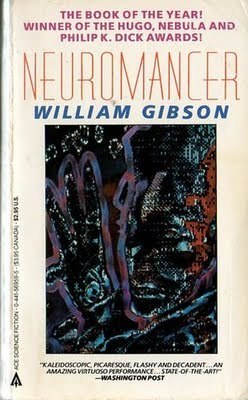Advance Team Tuesday: The sci-fi authors series continues with a slightly shorter post about William Gibson

I didn't discover William Gibson until college, a couple of years after his breakthrough novel, 1984's "Neuromancer," hit the shelves. So, unlike Philip Jose Farmer and Harlan Ellison, I never had that young fan's frenzy for reading every single book of his I could get my hands on (and, frankly, back then, Gibson didn't have that many books out).
But unlike Farmer and Ellison, Gibson -- a guy from another generation who was covering subjects completely different than those two -- delivered a style of slick, cool and above all modern (or at least modern-seeming) sci-fi that was just what I wanted to read at that point. I think the first time I heard Gibson's name was in a Comics Journal (there's that mag again) review of Howard Chaykin's "American Flagg," where the reviewer compared Chaykin's use of clever, slightly satirical names ("Mananacillin," "Nachtmacher") to Gibson's portrayal of a future where business and consumer interests were the driving force behind everything. Well, I loved "American Flagg" (still do, in fact), so I figured I'd better check this Gibson fellow out.
Gibson's style in his early writing was so slick and of-the-moment in the late 1980s that it feels a little bit dated these days, with all the edgy hackers and corporate assassins and neon-lit massive cities. But that's the risk you run with edgy writing -- eventually, it's going to seem a lot less edgy. It still reads well, decades later, and it's still a hell of a lot of fun. What's more, unlike almost everyone else, Gibson was able to tap into the feeling that something big was about the happen, and it had nothing to do with spaceships or aliens or jetpacks or robots. No, it had to do with those computers that were showing up on everyone's desks and the way you could connect them to a phone and use them to talk to other computers.
 Gibson didn't predict cyberspace, but he did paint a picture of it that still seems, if not accurate, then startlingly evocative. Here's what "console cowboy" Case sees when he finally "jacks in," from page 52 of my Ace Books paperback edition of "Neuromancer":
Gibson didn't predict cyberspace, but he did paint a picture of it that still seems, if not accurate, then startlingly evocative. Here's what "console cowboy" Case sees when he finally "jacks in," from page 52 of my Ace Books paperback edition of "Neuromancer":"And if flowed, flowered for him, fluid neon orgami trick, the unfolding of his distanceless home, his country, transparent 3D chessboard extending to infinity. Inner eye opening to the stepped scarlet pyramid of the Eastern Seaboard Fission Authority burning beyond the green cubes of Mitsubishi bank of America, and high and very far away he saw the spiral arms of military systems, forever beyond his reach."
That's a nice piece of writing, there. From the telling detail of the "Mitsubish Bank of America" to the almost Lovecraftian image of the "spiral arms of military systems," it really makes the internet seem like some overwhelming force that's barely understandable by mere humans. And I guess that's sort of what it is, isn't it -- though the real internet turned out to be (a) a lot more DIY than what Case glimpses and (b) a lot sloppier and less organized.
I mean, think about it. You're reading this blog post on the exact same thing Gibson describes in this paragraph. So where are those spiral arms?
By the way, this blog post -- and all the blog posts in the "Advance Team Tuesday" series -- are brought to you by "The Advance Team," the graphic novel Tor/Forge will be publishing in the spring, with script by yours truly and art by German Torres. Read more about it here.
And pick up a copy when it hits the stores, OK? Maybe it'll be my "Neuromancer."
Published on July 12, 2011 06:51
No comments have been added yet.
Will Pfeifer's Blog
- Will Pfeifer's profile
- 23 followers
Will Pfeifer isn't a Goodreads Author
(yet),
but they
do have a blog,
so here are some recent posts imported from
their feed.



